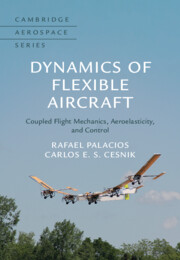Refine search
Actions for selected content:
14 results
Aeroelastic analysis of propeller blades at stall flutter onset
-
- Journal:
- The Aeronautical Journal , First View
- Published online by Cambridge University Press:
- 26 August 2025, pp. 1-21
-
- Article
-
- You have access
- Open access
- HTML
- Export citation
Aeroelastic stability of imperfectly supported high-aspect-ratio wings
-
- Journal:
- The Aeronautical Journal / Volume 129 / Issue 1340 / October 2025
- Published online by Cambridge University Press:
- 23 June 2025, pp. 2741-2756
-
- Article
-
- You have access
- Open access
- HTML
- Export citation
3 - Dynamics of Elastically Supported Rigid Airfoils
-
- Book:
- Dynamics of Flexible Aircraft
- Published online:
- 29 June 2023
- Print publication:
- 13 July 2023, pp 73-132
-
- Chapter
- Export citation
6 - Dynamics of Flexible Aircraft with Small-Amplitude Vibrations
-
- Book:
- Dynamics of Flexible Aircraft
- Published online:
- 29 June 2023
- Print publication:
- 13 July 2023, pp 209-276
-
- Chapter
- Export citation

Dynamics of Flexible Aircraft
- Coupled Flight Mechanics, Aeroelasticity, and Control
-
- Published online:
- 29 June 2023
- Print publication:
- 13 July 2023
5 - Flow-Induced Instabilities
-
- Book:
- Offshore Structure Hydrodynamics
- Published online:
- 31 January 2023
- Print publication:
- 05 January 2023, pp 132-157
-
- Chapter
- Export citation
Kinematic characteristics of longitudinal double folding wings
-
- Journal:
- The Aeronautical Journal / Volume 125 / Issue 1293 / November 2021
- Published online by Cambridge University Press:
- 17 June 2021, pp. 1977-2001
-
- Article
- Export citation
11 - Airload–Structure Interactions and Aero–Elastic Effects
-
- Book:
- Aircraft Aerodynamic Design with Computational Software
- Published online:
- 30 April 2021
- Print publication:
- 20 May 2021, pp 399-425
-
- Chapter
- Export citation
A semi-analytical approach for flutter analysis of a high-aspect-ratio wing
-
- Journal:
- The Aeronautical Journal / Volume 125 / Issue 1284 / February 2021
- Published online by Cambridge University Press:
- 07 August 2020, pp. 410-429
-
- Article
- Export citation
Estimation of three-dimensional aerodynamic damping using CFD
-
- Journal:
- The Aeronautical Journal / Volume 124 / Issue 1271 / January 2020
- Published online by Cambridge University Press:
- 12 November 2019, pp. 24-43
-
- Article
- Export citation
Dynamics and Stability of Pinned-Free Micropipes Conveying Fluid
-
- Journal:
- Journal of Mechanics / Volume 34 / Issue 4 / August 2018
- Published online by Cambridge University Press:
- 25 May 2017, pp. 533-539
- Print publication:
- August 2018
-
- Article
- Export citation
Design and flight test of active flutter suppression on the X-56A multi-utility technology test-bed aircraft
-
- Journal:
- The Aeronautical Journal / Volume 120 / Issue 1228 / June 2016
- Published online by Cambridge University Press:
- 10 May 2016, pp. 893-909
-
- Article
- Export citation
Stability for Leipholz’s Type of Laminated Box Columns with Nonsymmetric Lay-Ups on Elastic Foundation
-
- Journal:
- Advances in Applied Mathematics and Mechanics / Volume 7 / Issue 2 / April 2015
- Published online by Cambridge University Press:
- 23 March 2015, pp. 158-179
- Print publication:
- April 2015
-
- Article
- Export citation
Nonlinear Aerodynamic Effects on Transonic Flap Buzz, Tail Flutter and Limit-Cycle Oscillations of Two-Dimensional Wing-Flap-Tail Configurations
-
- Journal:
- Journal of Mechanics / Volume 25 / Issue 4 / December 2009
- Published online by Cambridge University Press:
- 05 May 2011, pp. 451-463
- Print publication:
- December 2009
-
- Article
- Export citation
